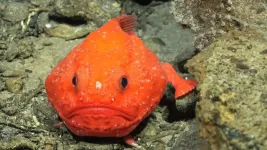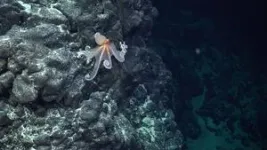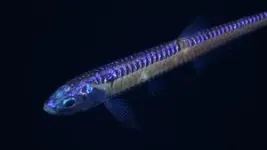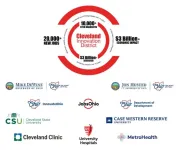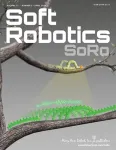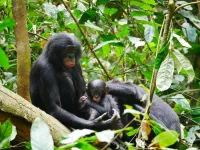International team co-led by a BSC researcher discovers more than 50 new deep-sea species in one of the most unexplored areas of the planet
The role of BSC and supercomputing in the expedition is to provide climate modelling data through different future scenarios to determine the distribution of species in the area
2024-04-12
(Press-News.org)
An international group of scientists, co-led by researcher Ariadna Mechó of the Barcelona Supercomputing Center - Centro Nacional de Supercomputación (BSC-CNS), observed 160 species on seamounts off the coast of Chile that had not yet been known to live in the region and suspect that at least 50 of these species are new to science. The recent Schmidt Ocean Institute expedition to the underwater mountains of the Salas y Gómez Ridge, a remote and underexplored area that stretches from offshore Chile to Rapa Nui, resulted in identifying deep-sea corals, glass sponges, sea urchins, squids, fishes, molluscs, crabs, sea stars, squat lobsters, and other species likely never-before observed by scientists.
Mechó, a researcher in the Climate Variability and Change group at the BSC’s Earth Sciences Department, presented the results of the 40-day scientific cruise ‘Unexplored Seamounts of the Salas y Gómez Ridge’ and the current negotiations to create a blue corridor in the area at the “Ocean Decade MPA Forum: Progress, obstacles and solutions”, an off-site event organised in the framework of the UN Ocean Decade Conference held in Barcelona from 10-12 April 2024.
“The main results of this campaign are that we have found between 50 and 60 potentially new species at first sight, a number that is likely to increase as we have many samples to work on in the laboratory. We also found one of the deepest mesophotic corals in the world, extending the distribution of this Polynesian fauna by several hundred kilometres. And at depth, we have found fields of sponges and corals, habitats that are considered vulnerable and in need of protection”, said Mechó.
The expedition took place from 24 February to 4 April with an international team of 25 scientists from 14 organisations in five countries (Chile, United States, Italy, Spain, Netherlands), including the first Rapa Nui marine biologist, Emilia Ra'a Palma Tuki, a recent graduate of the Universidad Católica del Norte in Chile. The Rapa Nui Sea Council, or Koro Nui o te Vaikava, supported the expedition, providing the main permit to work in the area, and collaborated by providing a Koro Nui observer and a local sailing expert to bring to the expedition their perspectives as members of the Rapa Nui community.
The information collected during this research expedition will provide the scientific basis to inform the management of existing marine protected areas and potentially expand them, especially around the island of Rapa Nui.
One of the most unexplored areas of the planet
Funded by the Schmidt Ocean Institute, the cruise is devoted to studying the ecosystems of one of the most unexplored areas of the world, the submarine mountains and oceanic islands of the Salas y Gómez Ridge, which is a 2,900-kilometre-long underwater mountain chain comprising more than 200 seamounts from offshore Chile to Rapa Nui, otherwise known as Easter Island (or Isla de Pascua).
This ridge hosts one of the most unique and biodiverse seascapes on Earth, with an extremely high rate of endemism, critical habitats for benthic organisms, essential migration corridors for highly mobile species, and the presence of over 80 threatened or endangered species.
In addition, the Salas y Gómez Ridge possesses a rich cultural and maritime heritage with profound connections to Indigenous islander and mainland communities and other nations. This remote, underexplored region likely harbours pristine and unexploited habitats with abundant biodiversity that require international cooperation to protect them before they are lost.
Modelling the ocean with supercomputing
The role of BSC and supercomputing in the campaign is to provide climate modelling data through different scenarios to establish the distribution of key species in the area. This will help us understand how these species will be impacted by future changes, depending on each possible scenario.
“But first, we need to better understand the biodiversity and connectivity of the region to know which keystone species are found there and on which mountains exactly, as well as potential faunal breaks (where communities change or stop connecting with each other). Basically, it is a unique exploration in places where practically everything is unexplored”, said Mechó.
The aim is to provide the critical information to support the designation of the Salas y Gomez Ridge as an ecologically and biologically significant marine area (EBSA) by the Convention on Biological Diversity and an ecological and socioeconomic ‘priority area’ for international protection, by the High Seas Treaty (2023).
This cruise was strongly connected with an earlier campaign deployed between January and February 2024 and focused on studying the junction between the Salas y Gomez and the Nazca Ridge, and the Desventuradas Islands. During the 2 cruises, more than 100 new species have been discovered on the Salas y Gomez and the Nazca Ridge (SyGR), as well as coral and sponge gardens. That will emphasise the need for a blue corridor along the Salas y Gómez and Nazca Ridges, creating one of the first and larger high-seas marine protected areas in the world.
[Ariadna Mechó received funding from the European Union’s Horizon 2020 research and innovation programme under the Marie Skłodowska-Curie grant agreement No GA 101107435]
END
ELSE PRESS RELEASES FROM THIS DATE:
2024-04-12
CLEVELAND – Since the Cleveland Innovation District launched in 2021, the founding institutions have made significant progress, including exceeding many of the targets set by the Ohio Department of Development and JobsOhio. Collectively, the institutions participating in this $500 million public-private initiative have created more than 2,600 jobs, spent nearly $1.2 billion on research and innovation, commenced construction of two new research facilities, created dedicated research space comprising more than 550,000 square feet, and awarded more than 7,300 degrees and certificates to support workforce development.
“The Cleveland Innovation District’s progress ...
2024-04-12
WASHINGTON (April 12, 2024) – A third of the nearly 20 million women who participated in a national health survey report migraines during menstruation, and of them, 11.8 million, or 52.5%, were premenopausal. The analysis was conducted by researchers at Georgetown University Medical Center and Pfizer, Inc., which makes a migraine medication.
Because of the underuse of medications to help treat or prevent menstrual migraines, investigators wanted to understand how common menstrual migraines were and which groups of women could most benefit from potential therapies. The study will be presented April 16, at the American Academy of Neurology ...
2024-04-12
HOUSTON ― The University of Texas MD Anderson Cancer Center’s Research Highlights showcases the latest breakthroughs in cancer care, research and prevention. These advances are made possible through seamless collaboration between MD Anderson’s world-leading clinicians and scientists, bringing discoveries from the lab to the clinic and back.
Recent developments at MD Anderson offer insights into a combination strategy to improve immunotherapy responses, promising trial results for patients with tumors harboring BRAF mutations, a maintenance strategy for patients with acute myeloid leukemia following chemotherapy, a strategy ...
2024-04-12
Mary Ann Liebert, Inc., is pleased that Barbara Mazzolai, PhD, has been appointed the new Deputy Editor-in-Chief of the bimonthly journal Soft Robotics. Dr. Mazzolai joins Barry Trimmer, PhD, as part of the executive editorial team for the journal.
Soft Robotics is the leading robotics journal devoted to the emerging technologies and developments of soft and deformable robots. The journal’s coverage includes flexible electronics, materials science, computer science, and biomechanics. The journal breaks new ground as the first to answer the urgent need for research on robotic technology that can safely ...
2024-04-12
Wiley, one of the world’s largest publishers and a global leader in research and learning, today announced the 2024 release of the Mass Spectra of Designer Drugs.
This indispensable spectral database serves as a cornerstone for forensic laboratories worldwide, enabling swift identification of illicit substances. Sourced from both legal and underground literature, it provides access to the latest novel psychoactive substances (NPS) like variants of fentanyl, xylazine, various opioids, synthetic cannabinoids, and more.
This annually refreshed database provides access to 35,094 mass spectra representing 26,712 unique ...
2024-04-12
By Ann Kellett, Texas A&M University School of Public Health
Freestanding emergency departments (EDs) — either satellite branches of hospitals or independently operated facilities — have popped up across the country. Texas has the most, with 338 freestanding EDs as of May 2023, and these facilities handle nearly one quarter of all emergency department visits in the state.
Now, a new study from the Texas A&M University School of Public Health is the first to compare the characteristics of visits to freestanding EDs with visits to traditional hospital-based ...
2024-04-12
University of Cincinnati researchers will present abstracts at the American Academy of Neurology annual meeting 2024, April 13-18 in Denver, Colorado.
Two-component treatment leads to improvement for patients
Late-onset Pompe disease (LOPD) is a rare, inherited genetic disease caused by the accumulation of glycogen, the body’s stored form of glucose, in muscles and other organs. Left untreated, the muscle weakness it causes can lead to the loss of the ability to walk and breathing impairment.
A research team led by UC’s ...
2024-04-12
Chimpanzees and bonobos are often thought to reflect two different sides of human nature—the conflict-ready chimpanzee versus the peaceful bonobo—but a new study publishing April 12 in the journal Current Biology shows that, within their own communities, male bonobos are more frequently aggressive than male chimpanzees. For both species, more aggressive males had more mating opportunities.
“Chimpanzees and bonobos use aggression in different ways for specific reasons,” says anthropologist and lead author Maud Mouginot of Boston University. “The idea is not to invalidate the ...
2024-04-12
A deep dive into macroalgae genetics has uncovered the genetic underpinnings that enabled macroalgae, or “seaweed,” to evolve multicellularity. Three lineages of macroalgae developed multicellularity independently and during very different time periods by acquiring genes that enable cell adhesion, extracellular matrix formation, and cell differentiation, researchers report April 12 in the journal Molecular Plant. Surprisingly, many of these multicellular-enabling genes had viral origins. The study, which increased the total number of sequenced macroalgal genomes from 14 to 124, is the first to investigate ...
2024-04-12
Melanoma is the deadliest form of skin cancer. With global incidence rates rising, new, more effective treatments are necessary to alleviate the health burden of the disease. Important advances in recent years include doctors using genetic tests to look for specific mutations they can target for more personalised, effective treatment.
Around 1 in 2 melanoma patients will have mutations in the BRAF gene. This gene normally makes a protein which helps control cell growth, but mutations can cause the cells to grow and divide uncontrollably instead, happening in many different types of cancer including ...
LAST 30 PRESS RELEASES:
[Press-News.org] International team co-led by a BSC researcher discovers more than 50 new deep-sea species in one of the most unexplored areas of the planet
The role of BSC and supercomputing in the expedition is to provide climate modelling data through different future scenarios to determine the distribution of species in the area
